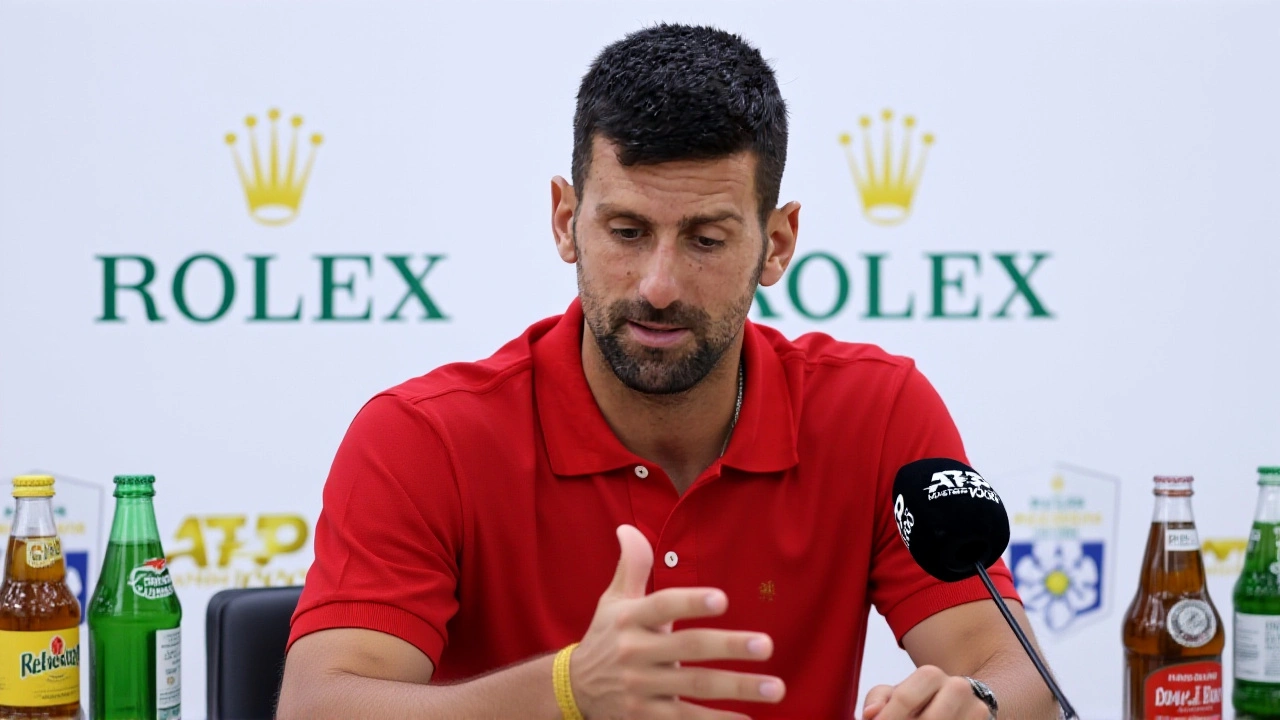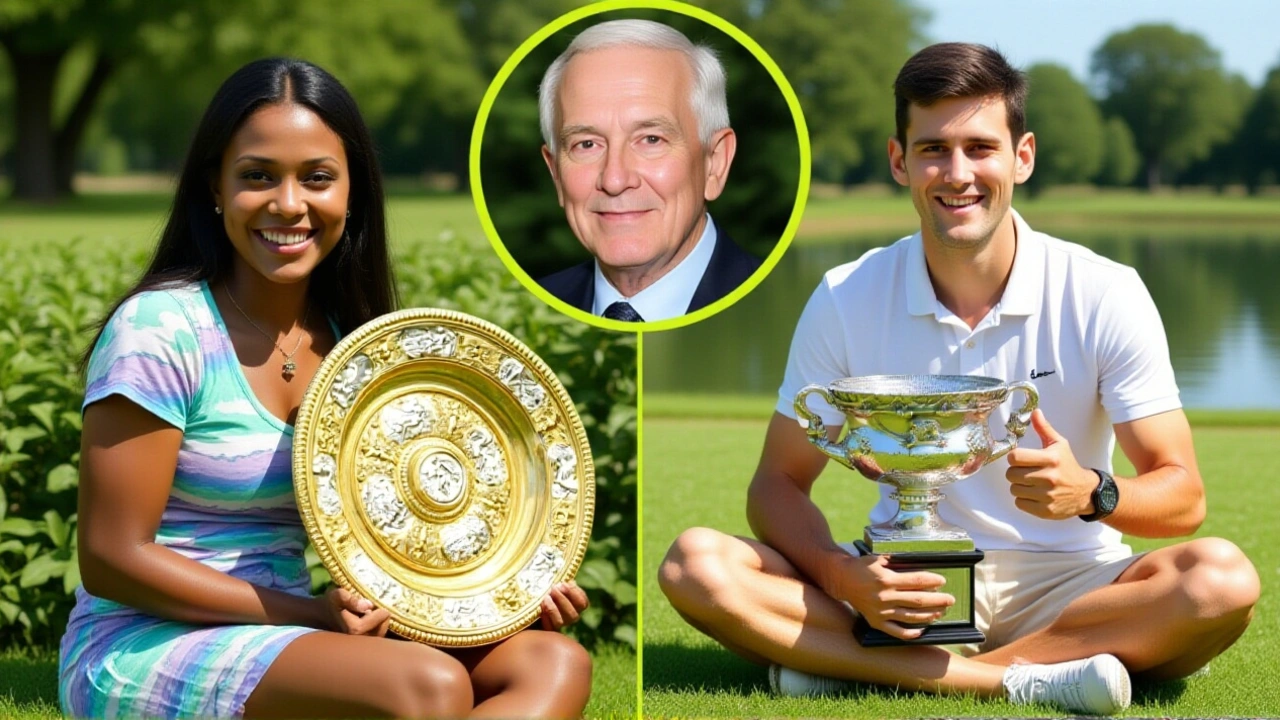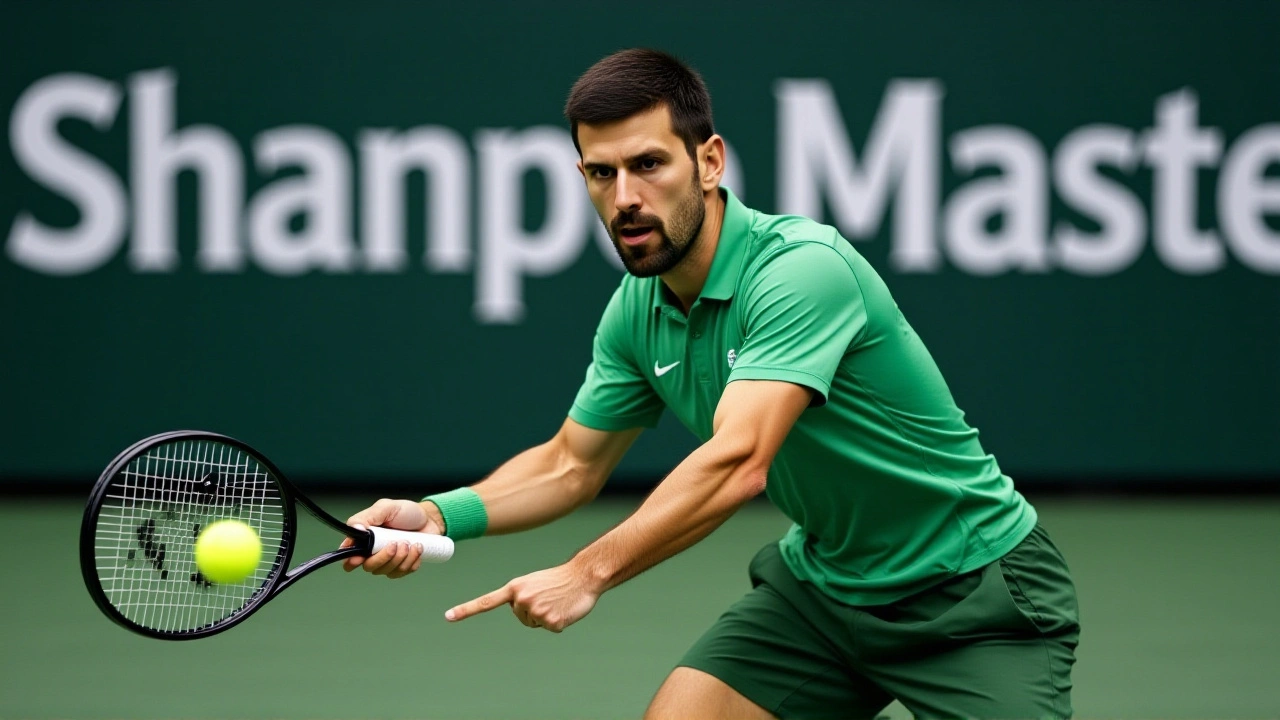6 Oct 2025
- 7 Comments
When Novak Djokovic, world No. 1 tennis player of ATP Tour stepped onto Centre Court in Shanghai on October 5, 2025, the air was thick enough to cut through a tennis racket. The Serbian ace, a four‑time former Shanghai champion, faced Germany’s Yannick Hanfmann, a player who peaked at world No. 45 in June 2023. What unfolded was a three‑set duel that tested not just skill but sheer survivability in what commentators called “brutal” heat and humidity.
Match Overview
The opening set saw Hanfmann dictating play with a mix of deep slice and sudden burst of pace. He rattled Djokovic with a 12‑0 run that included a deft drop‑shot that left the Serbian scrambling. Djokovic, however, leaned on his legendary defensive instincts and broke back at 4‑4, eventually taking the set 7‑5 after a relentless rally that lasted 12 minutes.
The second set turned into a tactical chess match. Hanfmann’s backhand down the line began to trouble Djokovic’s forehand, and for a few games the German seemed to have the upper hand. Yet the champion’s experience shone through; he altered his serve placement, targeting the body to compress Hanfmann’s angles, and snapped the set 6‑3.
By the third set the temperature had climbed to a recorded 31.4 °C (88.5 °F) with humidity hovering around 84 %. Sweat dripped into the players’ eyes, forcing both to wipe their faces between points. In those conditions, the Serbian’s superior fitness gave him the edge, and he closed the match 6‑4, securing a 2‑1 victory and a berth in the round of 32.
Playing Conditions in Shanghai
Shanghai in early October is notorious for sudden spikes in humidity, especially after a day’s rain. The venue, Qizhong Forest Sports City Arena, is an open‑air stadium, meaning the atmosphere is directly affected by the city’s weather. On the evening of the match, the local weather station reported a heat index of 38 °C (100 °F), a factor that the ATP’s medical team monitored closely.
During the match, Djokovic’s on‑court coach, Marian Vajda, was seen handing him a damp towel after every change‑over, a routine the Serbian has employed since his 2012 Australian Open triumph in similar conditions. “The humidity makes the ball feel heavier,” Vajda whispered into his headset, according to spectators.
Key Moments and Tactical Battles
One of the most talked‑about rallies came at 5‑4 in the third set. Hanfmann executed a rare behind‑the‑back shot that clipped the net cord and spun back into Djokovic’s court. The Serbian responded with a cross‑court forehand winner that seemed to lift the crowd’s spirit.
Hanfmann’s use of “trick shots” – a mix of slices, drop shots, and occasional volleys – reminded many of the stylish play of former world No. 8 Tommy Haas. Yet Djokovic’s ability to absorb those angles and redirect the ball at speed proved decisive.
Statistically, Djokovic served 8 aces and hit a first‑serve percentage of 66 % despite the sticky air. Hanfmann, on the other hand, converted 3 break points to 1, showing he struggled to capitalize when the pressure peaked.

Reactions from the Players
After the final point, a visibly exhausted Djokovic raised his hand in acknowledgement of the crowd. "I felt the heat in every breath," he said in the post‑match interview. "Yannick gave me a real test. I had to dig deep, not just physically but mentally. The conditions were like playing on a sauna floor, but that's part of the game here in Shanghai."
Hanfmann, clutching a towel, smiled despite the loss. "I’m proud of how I played," he told reporters. "I tried to disrupt Novak’s rhythm with a different pace, and for a while it worked. The humidity was horrible, but I think I proved I can compete at this level."
Former top‑10 player Tommy Robredo, now a commentator for the tournament, noted, "What Novak did today is a master class in endurance. Not many can handle 31 degrees and still keep a razor‑sharp focus. Yannick showed heart, but Djokovic’s conditioning is on another level."
What the Win Means for Djokovic's Campaign
The victory propels Djokovic into a field that includes reigning champion Jannik Sinner and rising star Carlos Alcaraz. With a prize purse of $1.5 million for the champion and 1000 ATP ranking points at stake, the Serbian’s next match could be a turning point on his push to end the season inside the top three.
Analyst Marty Smith of the Tennis Channel pointed out, "If Djokovic can keep this level of physical resilience, he’s in a great position to add a fifth Shanghai title – a record that would eclipse even his own Grand Slam tally."

Historical Context of Djokovic at Shanghai
Djokovic first lifted the Shanghai trophy in 2013, beating world No. 2 Rafael Nadal in a five‑set thriller. He repeated the feat in 2015 and 2018, each time showcasing his ability to adapt to the venue’s variable climate. The 2025 win would mark his fourth title there, tying him with Roger Federer for most Shanghai crowns.
The event, officially Rolex Shanghai Masters 2025Shanghai, runs from September 29 through October 12 and is a pivotal stop before the season‑ending ATP Finals. Players often use it to gauge form ahead of the November indoor swing.
Key Facts
- Match date: October 5, 2025
- Final score: Djokovic def. Hanfmann 7‑5, 6‑3, 6‑4
- Temperature: 31.4 °C (88.5 °F); Humidity: 84 %
- Djokovic’s first‑serve %: 66 %; Aces: 8
- ATP ranking points earned: 90 (first‑round win)
Frequently Asked Questions
How does the Shanghai heat affect player performance?
High humidity and temperatures above 30 °C make the ball heavier and reduce grip on the court surface. Players lose fluid faster, which can lower stamina and slow reaction times. In Djokovic’s case, his rigorous conditioning allowed him to maintain a high first‑serve percentage, whereas others often see a dip in serve speed as the match progresses.
What does this win mean for Novak Djokovic’s ranking?
The 90 points earned move Djokovic up two spots in the ATP rankings, bringing him within striking distance of a top‑three finish for the season. Consistent deep runs in Masters 1000 events are crucial for maintaining a year‑end position, especially with the ATP Finals on the horizon.
Who are Djokovic’s potential opponents in the next round?
The draw pits him against either world No. 8 Jannik Sinner or the qualifier who beat Sinner in the previous round, Lorenzo Musetti. Both are known for aggressive baseline play, which could test Djokovic’s defensive prowess.
How does Yannick Hanfmann’s performance rank historically for German players at Shanghai?
Hanfmann’s three‑set push is among the deepest runs for a German at the Masters 1000 event since Alexander Zverev reached the quarterfinals in 2021. His tactical variety showed that German players can still be competitive on fast, humid surfaces.
What are the tournament’s next key dates?
The quarterfinals are scheduled for October 9, semifinals on October 10, and the championship match on October 12, 2025. The final will be broadcast live on major sports networks worldwide, with a prize pool of $6.5 million in total.


Nathan Rodan
October 6, 2025The Shanghai heat is the kind of relentless furnace that tests not only the muscles but the very mental fabric of a champion.
The humidity crept up to 84 percent, the ball seemed to acquire a weight that even the most seasoned baseliners could feel in their forearms.
Novak Djokovic, whose regimen often reads like a military drill, has spent countless hours perfecting his fluid intake and breathing patterns to cope with such conditions.
His ability to sustain a 66 percent first‑serve percentage under these oppressive circumstances is a testimony to the years of disciplined practice he has logged.
While many of his contemporaries simply swing harder to compensate for the slower ball, Novak instead employs subtle variations in spin that allow the ball to cut through the air with surprising speed.
The match against Yannick Hanfmann showcased not just raw power but also a chess‑like patience, as each player tried to dictate the tempo on a court that felt more like a sauna floor than a sporting arena.
You could see Hanfmann’s attempt at trick shots-a drop‑shot here, a slice there-acting as a cultural ambassador for creative tennis, yet Novak’s defensive instincts turned those moments into opportunities to counter‑punch.
The rally at 5‑4 in the third set, which lasted over ten minutes, featured a rare behind‑the‑back attempt that reminded the crowd of the sport’s theatrical side.
What struck me most was the way Novak’s footwork remained light, as if the heat had not seeped into his joints, whereas many players around him showed signs of fatigue in their shuffling.
This is not merely a story of a single match; it reflects a broader evolution in tennis where conditioning has become as crucial as technique.
In years past, legends would retire early from matches simply because the sun baked the court, but today’s top athletes carry portable cooling devices and have personal nutritionists optimizing electrolyte balance.
Marian Vajda’s routine of handing a damp towel every change‑over, while seemingly small, is a strategic move that maintains a micro‑climate around the player’s face.
From a cultural perspective, the Shanghai Masters continues to be a showcase of how Asian climates influence the global tennis calendar, demanding adaptations that are as much about mindset as about physical preparation.
The fact that Djokovic managed to close the match with a 6‑4 third set despite the rising temperature of 31.4 °C illustrates a mastery that will be studied by coaches for years to come.
In short, the victory is a master class in endurance, tactical flexibility, and the subtle art of staying cool when the world around you is anything but.
KABIR SETHI
October 17, 2025The stats paint a picture that goes beyond the scoreboard.
Eight aces might sound modest, but under a heat index of 38 °C each one is a precision strike.
His first‑serve percentage held steady at 66 percent, a figure that would impress any analyst even on a mild day.
Meanwhile, Hanfmann’s three break points turned into a single conversion, highlighting how the humidity can sap concentration.
These numbers suggest that Djokovic’s conditioning program is not just about stamina, but about sustaining neuromuscular sharpness when the environment tries to dull it.
It’s a reminder that elite tennis is as much a battle of chemistry as it is of skill.
rudal rajbhar
October 29, 2025Heat, in many philosophical traditions, is a metaphor for pressure that forges character.
When a player steps onto a court that feels like a sauna, the external temperature becomes a mirror for internal resolve.
Djokovic’s ability to stay composed suggests a deep alignment between mind and body, a unity that many seek but few achieve.
The sweat that drips into his eyes is not merely a physical byproduct but a symbolic cleansing of doubt.
In contrast, Hanfmann’s daring trick shots represent the creative spirit trying to flourish despite oppressive conditions.
Both narratives intertwine, showing that mastery arises from embracing, rather than resisting, the heat of circumstance.
Thus, the match becomes a living lesson: adversity is not an obstacle but a canvas for expression.
Reid Vance
November 9, 2025From a technical standpoint, the heat index of 38 °C effectively adds about 0.5 seconds to ball flight, which can alter timing for even top players.
Historical data shows that matches played above 30 °C see a 12 % increase in unforced errors across the board.
Djokovic’s endurance can be partially attributed to his VO₂ max, reportedly in the upper 70s, giving him a physiological edge in oxygen delivery.
Additionally, his diet includes beetroot juice, known to improve blood flow, which likely contributed to his sustained first‑serve percentages.
These variables combine to make his performance not just a triumph of will, but an embodiment of sports science applied at the highest level.
Javier cox
November 21, 2025What a match! Djokovic really showed why he’s a legend.
Even with teh heat, he kept his cool and smashed those aces.
Giacinta Pace
December 2, 2025Awesome effort by both players! Keep pushing and stay positive.
darryl archer
December 14, 2025The performance exhibited an elegance befitting of a Grand Slam champion, yet one must note the minor deviation in his footwork at 31°C which, albeit subtle, hinted at the relentless impact of the environment on elite execution.